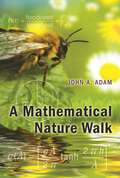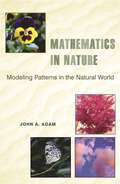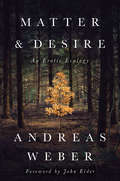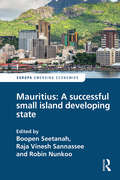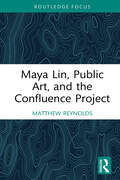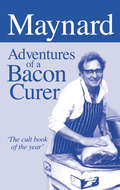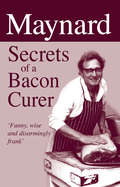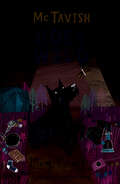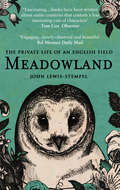- Table View
- List View
A Mathematical Nature Walk
by John A. AdamHow heavy is that cloud? Why can you see farther in rain than in fog? Why are the droplets on that spider web spaced apart so evenly? If you have ever asked questions like these while outdoors, and wondered how you might figure out the answers, this is a book for you. An entertaining and informative collection of fascinating puzzles from the natural world around us, A Mathematical Nature Walk will delight anyone who loves nature or math or both. John Adam presents ninety-six questions about many common natural phenomena--and a few uncommon ones--and then shows how to answer them using mostly basic mathematics. Can you weigh a pumpkin just by carefully looking at it? Why can you see farther in rain than in fog? What causes the variations in the colors of butterfly wings, bird feathers, and oil slicks? And why are large haystacks prone to spontaneous combustion? These are just a few of the questions you'll find inside. Many of the problems are illustrated with photos and drawings, and the book also has answers, a glossary of terms, and a list of some of the patterns found in nature. About a quarter of the questions can be answered with arithmetic, and many of the rest require only precalculus. But regardless of math background, readers will learn from the informal descriptions of the problems and gain a new appreciation of the beauty of nature and the mathematics that lies behind it.
A Mathematical Nature Walk (PDF)
by John A. AdamHow heavy is that cloud? Why can you see farther in rain than in fog? Why are the droplets on that spider web spaced apart so evenly? If you have ever asked questions like these while outdoors, and wondered how you might figure out the answers, this is a book for you. An entertaining and informative collection of fascinating puzzles from the natural world around us, A Mathematical Nature Walk will delight anyone who loves nature or math or both. John Adam presents ninety-six questions about many common natural phenomena--and a few uncommon ones--and then shows how to answer them using mostly basic mathematics. Can you weigh a pumpkin just by carefully looking at it? Why can you see farther in rain than in fog? What causes the variations in the colors of butterfly wings, bird feathers, and oil slicks? And why are large haystacks prone to spontaneous combustion? These are just a few of the questions you'll find inside. Many of the problems are illustrated with photos and drawings, and the book also has answers, a glossary of terms, and a list of some of the patterns found in nature. About a quarter of the questions can be answered with arithmetic, and many of the rest require only precalculus. But regardless of math background, readers will learn from the informal descriptions of the problems and gain a new appreciation of the beauty of nature and the mathematics that lies behind it.
Mathematics in Nature: Modeling Patterns in the Natural World
by John A. AdamFrom rainbows, river meanders, and shadows to spider webs, honeycombs, and the markings on animal coats, the visible world is full of patterns that can be described mathematically. Examining such readily observable phenomena, this book introduces readers to the beauty of nature as revealed by mathematics and the beauty of mathematics as revealed in nature. Generously illustrated, written in an informal style, and replete with examples from everyday life, Mathematics in Nature is an excellent and undaunting introduction to the ideas and methods of mathematical modeling. It illustrates how mathematics can be used to formulate and solve puzzles observed in nature and to interpret the solutions. In the process, it teaches such topics as the art of estimation and the effects of scale, particularly what happens as things get bigger. Readers will develop an understanding of the symbiosis that exists between basic scientific principles and their mathematical expressions as well as a deeper appreciation for such natural phenomena as cloud formations, halos and glories, tree heights and leaf patterns, butterfly and moth wings, and even puddles and mud cracks. Developed out of a university course, this book makes an ideal supplemental text for courses in applied mathematics and mathematical modeling. It will also appeal to mathematics educators and enthusiasts at all levels, and is designed so that it can be dipped into at leisure.
Mathematics in Nature: Modeling Patterns in the Natural World
by John A. AdamFrom rainbows, river meanders, and shadows to spider webs, honeycombs, and the markings on animal coats, the visible world is full of patterns that can be described mathematically. Examining such readily observable phenomena, this book introduces readers to the beauty of nature as revealed by mathematics and the beauty of mathematics as revealed in nature. Generously illustrated, written in an informal style, and replete with examples from everyday life, Mathematics in Nature is an excellent and undaunting introduction to the ideas and methods of mathematical modeling. It illustrates how mathematics can be used to formulate and solve puzzles observed in nature and to interpret the solutions. In the process, it teaches such topics as the art of estimation and the effects of scale, particularly what happens as things get bigger. Readers will develop an understanding of the symbiosis that exists between basic scientific principles and their mathematical expressions as well as a deeper appreciation for such natural phenomena as cloud formations, halos and glories, tree heights and leaf patterns, butterfly and moth wings, and even puddles and mud cracks. Developed out of a university course, this book makes an ideal supplemental text for courses in applied mathematics and mathematical modeling. It will also appeal to mathematics educators and enthusiasts at all levels, and is designed so that it can be dipped into at leisure.
The Mathematics of Blunt Body Sampling (Lecture Notes in Engineering #38)
by Sarah J. Dunnett Derek B. InghamParticle samplers are widely used in workplaces in order to determine the concentration of airborne particles in the atmosphere. They generally operate by drawing air, with the aid of a pump, through one or more orifices in the sampler body and housed within the sampler is a filter through which the air is subsequently drawn. The airborne particles are collected on the filter and their concentration is determined. Various samplers have been designed for this purpose including "static" samplers, which are located in a fixed position in a working environment and determine the dust concentration averaged over a prescribed period of time at that one point, and "personal" samplers which are mounted on a working person near to the breathing zone. The ORB sampler, a static sampler designed by Ogden and Birkett (1978) to have approximately the same entry efficiency, for particles with aerodynamical diameter up to at least 25~m, as a human head equally exposed to all wind directions for wind speeds between 0 and 2. 75m1s, is shown in Fig. l. l and examples of personal samplers are shown in Fig. 1. 2a, b and c and represent a single 4mm hole sampler, a seven hole sampler and a 25mm open face filter holder respectively. These three samplers are some of the most commonly used personal samplers for sampling the total airborne concentrations of workplace dusts in Britain.
Mathematics of Planet Earth: Protecting Our Planet, Learning from the Past, Safeguarding for the Future (Mathematics of Planet Earth #5)
by Hans G. Kaper Fred S. RobertsSince its inception in 2013, Mathematics of Planet Earth (MPE) focuses on mathematical issues arising in the study of our planet. Interested in the impact of human activities on the Earth’s system, this multidisciplinary field considers the planet not only as a physical system, but also as a system supporting life, a system organized by humans, and a system at risk. The articles collected in this volume demonstrate the breadth of techniques and tools from mathematics, statistics, and operations research used in MPE. Topics include climate modeling, the spread of infectious diseases, stability of ecosystems, ecosystem services, biodiversity, infrastructure restoration after an extreme event, urban environments, food security, and food safety. Demonstrating the mathematical sciences in action, this book presents real-world challenges for the mathematical sciences, highlighting applications to issues of current concern to society. Arranged into three topical sections (Geo- and Physical Sciences; Life Sciences, Ecology and Evolution; Socio-economics and Infrastructure), thirteen chapters address questions such as how to measure biodiversity, what mathematics can say about the sixth mass extinction, how to optimize the long-term human use of natural capital, and the impact of data on infrastructure management. The book also treats the subject of infectious diseases with new examples and presents an introduction to the mathematics of food systems and food security. Each chapter functions as an introduction that can be studied independently, offering source material for graduate student seminars and self-study. The range of featured research topics provides mathematical scientists with starting points for the study of our planet and the impact of human activities. At the same time, it offers application scientists a plethora of modern mathematical tools and techniques to address the various topics in practice. Including hundreds of references to the vast literature associated with each topic, this book serves as an inspiration for further research.
Matsutake Worlds (Studies in Social Analysis #12)
by Lieba Faier and Michael J. HathawayThe matsutake mushroom continues to be a highly sought delicacy, especially in Chinese, Japanese, and Korean cuisine. Matsutake Worlds explores this mushroom through the lens of multi-species encounters centered around the matsutake’s notorious elusiveness. The mushroom’s success, the contributors of this volume argue, cannot be accounted for by any one cultural, social, political, or economic process. Rather, the matsutake mushroom has flourished as the result of a number of different processes and dynamics, culminating in the culinary institution we know today.
Matter and Desire: An Erotic Ecology
by Dr Andreas Weber John ElderNautilus Award Gold Medal Winner, Ecology & Environment In Matter and Desire, internationally renowned biologist and philosopher Andreas Weber rewrites ecology as a tender practice of forging relationships, of yearning for connections, and of expressing these desires through our bodies. Being alive is an erotic process—constantly transforming the self through contact with others, desiring ever more life. In clever and surprising ways, Weber recognizes that love—the impulse to establish connections, to intermingle, to weave our existence poetically together with that of other beings—is a foundational principle of reality. The fact that we disregard this principle lies at the core of a global crisis of meaning that plays out in the avalanche of species loss and in our belief that the world is a dead mechanism controlled through economic efficiency. Although rooted in scientific observation, Matter and Desire becomes a tender philosophy for the Anthropocene, a “poetic materialism,” that closes the gap between mind and matter. Ultimately, Weber discovers, in order to save life on Earth—and our own meaningful existence as human beings—we must learn to love.
The Matter of Death: Space, Place and Materiality
by J. Hockey C. Komaromy K. WoodthorpeThis collection opens up spaces where lives end, bodies are disposed of and memories generated: hospitals, hospices, care homes, coroners' courts, funeral premises, cemeteries, roadsides, the spirit world. Using material culture studies it illuminates the ways human beings make meaningful the challenges of death, dying and bereavement.
Matter Transmission: Mediation in a Paleocyber Age
by Nicolás Salazar SutilArguing for a paleocybernetic approach to current media studies debates, Nicolas Salazar Sutil develops an original framework for a new media ecology that embraces the primitive, the prehistoric, and the brute. Paying serious attention to materials used for cultural mediation that are unprocessed, unexplained, and raw such as bones and limestones, Salazar Sutil posits that advanced industrialisation of new media technology has prompted countercultural movements that call for radical new ways of transmitting culture, for instance through an experiential and high-tech appreciation of prehistoric landscape heritage. The future calls for a Palaeolithic awareness of living landscape as medium for the embodied transmission of cultural imaginaries and memories. The more media technology spurs mass forms of instantaneous media communication, the greater the need for primitive knowledge of earthling body and earthly landscape, our prime media for sustainable cultural transmission.
Matter Transmission: Mediation in a Paleocyber Age
by Nicolás Salazar SutilArguing for a paleocybernetic approach to current media studies debates, Nicolas Salazar Sutil develops an original framework for a new media ecology that embraces the primitive, the prehistoric, and the brute. Paying serious attention to materials used for cultural mediation that are unprocessed, unexplained, and raw such as bones and limestones, Salazar Sutil posits that advanced industrialisation of new media technology has prompted countercultural movements that call for radical new ways of transmitting culture, for instance through an experiential and high-tech appreciation of prehistoric landscape heritage. The future calls for a Palaeolithic awareness of living landscape as medium for the embodied transmission of cultural imaginaries and memories. The more media technology spurs mass forms of instantaneous media communication, the greater the need for primitive knowledge of earthling body and earthly landscape, our prime media for sustainable cultural transmission.
Mauritius: A successful Small Island Developing State (Europa Perspectives: Emerging Economies)
by Boopen Seetanah Raja Vinesh Sannassee Robin NunkooThe economic upturn and performance of Mauritius is a far cry from predictions made in the 1960s. The island’s remarkable economic performance since the 1980s can been attributed to a multitude of factors instrumental to the success of the economy, including structural reforms, outward looking export orientated strategies, diversification in the manufacturing, tourism and financial services sectors amongst others, sound economic governance and institutions, and significant investment in human capital. This book attempts to provide a detailed analysis of the various key ingredients which have helped to propel Mauritius to its current status. The various chapters provide important readings for both academics and policymakers, with the final chapter providing key policy strategies which the government needs to implement to help Mauritius graduate to the next level of development: namely to that of a high-income economy and, in moving out of the middle-income trap, laying the foundations for future growth and shared prosperity in the light of both domestic challenges and global constraints.
Mauritius: A successful Small Island Developing State (Europa Perspectives: Emerging Economies)
by Boopen Seetanah Raja Vinesh Sannassee Robin NunkooThe economic upturn and performance of Mauritius is a far cry from predictions made in the 1960s. The island’s remarkable economic performance since the 1980s can been attributed to a multitude of factors instrumental to the success of the economy, including structural reforms, outward looking export orientated strategies, diversification in the manufacturing, tourism and financial services sectors amongst others, sound economic governance and institutions, and significant investment in human capital. This book attempts to provide a detailed analysis of the various key ingredients which have helped to propel Mauritius to its current status. The various chapters provide important readings for both academics and policymakers, with the final chapter providing key policy strategies which the government needs to implement to help Mauritius graduate to the next level of development: namely to that of a high-income economy and, in moving out of the middle-income trap, laying the foundations for future growth and shared prosperity in the light of both domestic challenges and global constraints.
The Maverick Mountaineer: The Remarkable Life of George Ingle Finch: Climber, Scientist, Inventor
by Robert WainwrightWINNER OF THE TIMES 2017 BIOGRAPHY OF THE YEAR PRIZE SHORTLISTED FOR THE 2016 BOARDMAN TASKER PRIZE FOR MOUNTAIN LITERATURE'One of the two best Alpinists of his time - Mallory was the other.' The TimesIn the spring of 1901 a teenager stood on top of a hill, gazed out in wonderment at the Australian landscape and decided he wanted to be a mountaineer. Two decades later, the same man stood in a blizzard beneath the summit of Mount Everest, within sight of his goal to be the first to stand on the roof of the world. George Finch was at the highest point ever reached by a human being and only his decision to save the life of his stricken companion stopped him from reaching the summit.George Finch was a rebel of the first order, a man who dared to challenge the British establishment who disliked his independence, background, long hair and lack of an Oxbridge education. Despite this, he not only became one of the world's greatest alpinists, earning the grudging respect of his rival George Mallory, but pioneered the use of the artificial oxygen that enabled Everest to finally be conquered thirty years after his own attempt. A renowned scientist, a World War I hero and a Fellow of the Royal Society, involved in the development of some of the twentieth century's most important inventions, his skills helped save London from burning to the ground during the Blitz. Finch's public accomplishments, however, were shadowed by his complicated private life and his fraught relationship with his son, the actor Peter Finch.Acclaimed biographer Robert Wainwright restores George Finch to his rightful place in history with this remarkable tribute to one of the twentieth century's most eccentric anti-heroes.
Max Einstein: World Champions! (Max Einstein Series #4)
by James PattersonMax finally meets her hero, Albert Einstein, as she dashes across glaciers, visits the Great Barrier Reef, and flies a solar-powered jet in a race to stop global warming - before it's too late for planet earth.So far, Max and her team of genius friends have solved problems that no one else could, including: bringing solar energy to remote locations, producing clean drinking water across the globe, and ending world hunger. No easy task, even for a genius! But now Max and her friends must take on their biggest challenge yet, something that affects every living creature on the planet.Max must figure out how to prevent climate change from destroying the earth.But sinister forces want to keep Max from succeeding, and this time, even the very foundation of the Change Makers Institute is threatened. Now Max must not only save herself and her friends, but the entire planet, too.
Maxwell's Ghost: An Epilogue to Gavin Maxwell's Camusfearna
by Richard FrereFirst published by Gollancz, then by Balnain, Maxwell's Ghost is a classic account of the life and achievements of Gavin Maxwell, whose work and beliefs have attained an almost mythical status. Ring of Bright Water by Gavin Maxwell is one of the most famous and best selling books of natural history in the twentieth century. Yet the man who wrote it remains a fascinating and enduring enigma. This is a personal and sympathetic look at this extraordinary man during his last tumultuous years. Maxwell's Ghost caused a stir when it was published in 1976 because it dealt candidly with its subject's homosexual friendships. This aspect of the man had not been common knowledge even among Maxwell's close friends, and certainly had not been touched upon in the 1969 film of Ring of Bright Water which Frere always called 'notably inane' or in Maxwell's memoir from the previous year, Raven Seek Thy Brother. Frere denied sensationalizing in his book. He said that Maxwell had asked him on his death-bed to write it, and 'demanded that I write a true and impartial account'. Maxwell's Ghost is a grittily honest portrayal of Gavin Maxwell through the destruction of Camusfearna to his final acceptance of the inevitability of his death.
Maya Lin, Public Art, and the Confluence Project (Routledge Focus on Art History and Visual Studies)
by Matthew ReynoldsThe first scholarly monograph devoted exclusively to this vital work of contemporary public art, this book examines Maya Lin’s Confluence Project through the lens of environmental humanities and Indigenous studies. Matthew Reynolds provides a detailed analysis of each earthwork, along with a discussion of the proposed final project at Celilo Falls near The Dalles, Oregon. The book assesses the artist’s longtime engagement with the region of the Pacific Northwest and explores the Confluence Project within Lin’s larger oeuvre. Several consistent themes and experiences are common amongst all the sites. These include an emphasis on individual, multisensory encounters with the earthworks and their surrounding contexts; sound as an experiential dimension of landscape; indexical accounts of the multicultural, multispecies histories of each place; and an evocation of loss. The book will be of interest to scholars working in art history, contemporary art, environmental studies, environmental humanities, and Native American studies.
Maya Lin, Public Art, and the Confluence Project (Routledge Focus on Art History and Visual Studies)
by Matthew ReynoldsThe first scholarly monograph devoted exclusively to this vital work of contemporary public art, this book examines Maya Lin’s Confluence Project through the lens of environmental humanities and Indigenous studies. Matthew Reynolds provides a detailed analysis of each earthwork, along with a discussion of the proposed final project at Celilo Falls near The Dalles, Oregon. The book assesses the artist’s longtime engagement with the region of the Pacific Northwest and explores the Confluence Project within Lin’s larger oeuvre. Several consistent themes and experiences are common amongst all the sites. These include an emphasis on individual, multisensory encounters with the earthworks and their surrounding contexts; sound as an experiential dimension of landscape; indexical accounts of the multicultural, multispecies histories of each place; and an evocation of loss. The book will be of interest to scholars working in art history, contemporary art, environmental studies, environmental humanities, and Native American studies.
Maya & Marley and the Great Big Tidy Up: The brand new picture book from the creator of JoJo and Gran Gran
by Laura Henry-Allain"Join Maya and Marley on their Great Big Tidy Up where they show us how with a little bit of effort we can all make our communities joyous, clean and safe spaces. This is a wonderfully inspiring tale that shows children just how empowered they can be."Joseph Coelho, OBE, former Children's Laureate 2022-2024"Where children’s books are concerned Laura sets the standard."Patrick HutchinsonSiblings Maya and Marley are ready to take charge and make a change in this brand new picture book by Laura Henry-Allain, creator of Jo Jo & Gran Gran!"I'm wondering, I'm wondering... we need to have a great big tidy up!"Maya and Marley live in their very own playground with Mum, Dad and pet goats Lou and Chou!But when the playground becomes overrun with litter, it's up to Maya and Marley to plan a tidy up! Will they be able to clear it all away by themselves?A warm and adventurous picture book from bestselling author, Laura Henry-Allain, that promotes empathy and caring for the world around you.
Maynard, Adventures of a Bacon Curer: Adventures Of A Bacon Curer
by Maynard DaviesMaynard Davies, the last of the apprentice bacon curers, tells his intriguing story in his own distinctive style. Always one to turn a challenge into an opportunity, Maynard took pleasure in learning the skills of the old master curers of the Black Country and he shares with the reader the secrets of top quality bacon, learnt over a lifetime: the methods, recipes, smoking and curing. His passion for, as he puts it, 'good food for good people', is his motivation - made by experts, using the best ingredients, and cutting no corners. Funny, wise and very human, Maynard's unsentimental tale will remind readers that old fashioned virtues of pride in one's profession, hard work, an open mind and a lot of optimism go along way.
Maynard, Secrets of a Bacon Curer
by Maynard DaviesFans of Maynard will be delighted to read his further adventures in bacon curing. The last of the traditionally-apprenticed bacon curers, the author regales and inspires his readers with tales of visits from the health inspectors his colourful customers and work colleagues his tips on curing, smoking and selling the burglaries, bungled deals and triumphs his growing reputation in the field travels to learn how to make parma ham and much more. This book is the same addictive concoction of humour, tragedy and plain common sense, told in Maynard's disarmingly frank manner.
McGlue: From the author of TikTok sensations My Year of Rest and Relaxation and Lapvona (The\fence Modern Prize In Prose Ser.)
by Ottessa MoshfeghDive into the extended Ottessa Moshfegh universe with a special edition of McGlue, the novel that catapulted Moshfegh to literary stardom'One of America's most exciting - and most provocative - young novelists' Financial Times'You’re in safe, if sticky hands... A wild ride' The TimesSomewhere in the Indian Ocean, 1851: McGlue is down in the hold, still too drunk to be sure of his name, situation or orientation – but he has blood on his hands. He may have killed a man. That man may have been his best friend. As the ship makes its voyage home to Salem, Massachusetts, intolerable memory accompanies reluctant sobriety.A-sail on the high seas of literary tradition, Ottessa Moshfegh gives us a nasty heartless blackguard on a knife-sharp voyage through the fogs of recollection.
McTavish (McTavish #2)
by Meg RosoffA glorious sequel to Good Dog McTavish, this endearing story is brimming with Meg Rosoff’s stylish prose, quirky humour, astute eye for the details of canine-human dynamics, and the oddities of family life.
Me & You: A bittersweet story of friendship, love and loss
by Claudia CarrollWhat happens when your past catches up with you... Heartwarming and uplifting. "I'm fine. I'm sorry. Please take care of him for me. And maybe one day I'll get to explain." Angie knows a lot about her best friend Kitty. She knows Kitty is mad and wild and loves to wear clashing colors. She knows she's incredibly funny and generous but also very unreliable. And she knows that there is a perfect explanation for Kitty standing her up on her birthday. She thinks she knows everything about Kitty, except that she doesn't. Kitty knows that she is the happiest she has ever been. She knows she's so lucky to have a lovely boyfriend and a best friend like Angie. But what she doesn't know is one night, her past is finally going to catch up with her and change everything. If you adore Marian Keyes and Jojo Moyes, then you'll love Claudia Carroll's Me & You.
Meadowland: the private life of an English field
by John Lewis-StempelWINNER OF THE THWAITES WAINWRIGHT PRIZE 2015What really goes on in the long grass?Meadowland gives an unique and intimate account of an English meadow’s life from January to December, together with its biography. In exquisite prose, John Lewis-Stempel records the passage of the seasons from cowslips in spring to the hay-cutting of summer and grazing in autumn, and includes the biographies of the animals that inhabit the grass and the soil beneath: the badger clan, the fox family, the rabbit warren,the skylark brood and the curlew pair, among others. Their births, lives, and deaths are stories that thread through the book from first page to last.
